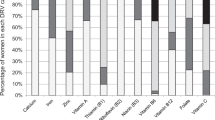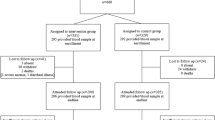Abstract
Biofortified maize, designed as an intervention strategy to prevent vitamin A deficiency, can provide upwards of 15 μg β-carotene per g dry weight. Some varieties also have elevated concentrations of other carotenoids. We conducted a cluster randomized, controlled feeding trial in rural Zambia to test the impact of daily consumption of biofortified maize over a 6-month period on vitamin A status. Serum concentrations of retinol and carotenoids were assessed by high-performance liquid chromatography. Data on circulating carotenoids by intervention group in 679 children are reported here. As previously shown, consumption of this β-carotene-rich maize significantly improved serum β-carotene concentrations (0.273 vs. 0.147 μmol/L, p < 0.001, in this subset of children). Here we show significant increases in α-carotene, β-cryptoxanthin, and zeaxanthin (p < 0.001). There was no impact on lutein or lycopene concentrations. Consumption of biofortified maize can have broader implications beyond the control of vitamin A deficiency (Trial registration: NCT01695148).
This is a preview of subscription content, access via your institution
Access options
Subscribe to this journal
Receive 12 print issues and online access
$259.00 per year
only $21.58 per issue
Buy this article
- Purchase on Springer Link
- Instant access to full article PDF
Prices may be subject to local taxes which are calculated during checkout
Similar content being viewed by others
References
Pillay K, Siwela M, Derera J, Veldman FJ, Provitamin A carotenoids in biofortified maize and their retention during processing and preparation of South African maize foods. J Food Sci Technol. 2014;51:634–44. https://doi.org/10.1007/s13197-011-0559-x.
Haskell MJ, Tanumihardjo SA, Palmer AC, Melse-Boonstra A, Talsma EF, Burri BJ. Effect of regular consumption of provitamin A biofortified staple crops on vitamin A status in populations in low-income countries. Afr J Food Agr Nutr Dev. 2017;17:11865–78.
Palmer AC, Siamusantu W, Chileshe J, Schulze KJ, Barffour M, Craft NE, et al. Provitamin A-biofortified maize increases serum beta-carotene, but not retinol, in marginally nourished children: a cluster-randomized trial in rural Zambia. Am J Clin Nutr. 2016;104:181–90. https://doi.org/10.3945/ajcn.116.132571.
Harjes CE, Rocheford TR, Bai L, Brutnell TP, Kandianis CB, Sowinski SG, et al. Natural genetic variation in lycopene epsilon cyclase tapped for maize biofortification. Science. 2008;319:330–3. https://doi.org/10.1126/science.1150255.
Chandler K, Lipka AE, Owens BF, Li HH, Buckler ES, Rocheford T, et al. Genetic analysis of visually scored orange kernel color in maize. Crop Sci. 2013;53:189–200. https://doi.org/10.2135/cropsci2012.02.0129.
Burri BJ, Beta-cryptoxanthin as a source of vitamin A. J Sci Food Agric. 2015;95:1786–94. https://doi.org/10.1002/jsfa.6942.
Ford ES, Gillespie C, Ballew C, Sowell A, Mannino DM. Serum carotenoid concentrations in US children and adolescents. Am J Clin Nutr. 2002;76:818–27.
Sheftel J, Gannon BM, Davis CR, Tanumihardjo SA, Provitamin A-biofortified maize consumption increases serum xanthophylls and 13C-natural abundance of retinol in Zambian children. Exp Biol Med (Maywood). 2017;242:1508–14. https://doi.org/10.1177/1535370217728500.
Miao B, Wang XD. Provitamin A carotenoids and cancer prevention. In: Tanumihardjo S, editor. Carotenoids and human health. New York, NY: Humana Press; 2012.
Lima VC, Rosen RB, Farah M, Macular pigment in retinal health and disease. Int J Retin Vitr. 2016;2:19. https://doi.org/10.1186/s40942-016-0044-9.
Acknowledgements
We thank the Mkushi District Management Team, Fabiana Moura, and Erick Boy for their support and acknowledge Sherry Tanumihardjo for testing food samples.
Funding
Funding for this study was provided by HarvestPlus (Grant #8251), Washington, DC, with support from the UK Department for International Development. Additional support was provided by the Sight and Life Global Research Institute of Johns Hopkins University.
Author information
Authors and Affiliations
Corresponding author
Ethics declarations
Conflict of interest
The authors declare that they have no conflict of interest.
Rights and permissions
About this article
Cite this article
Palmer, A.C., Craft, N.E., Schulze, K.J. et al. Impact of biofortified maize consumption on serum carotenoid concentrations in Zambian children. Eur J Clin Nutr 72, 301–303 (2018). https://doi.org/10.1038/s41430-017-0054-1
Received:
Revised:
Accepted:
Published:
Issue Date:
DOI: https://doi.org/10.1038/s41430-017-0054-1



